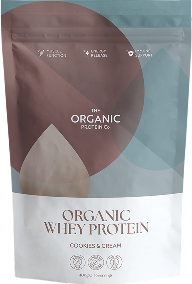For many of us, a convenient pouch of whey protein powder – or perhaps a plant-based blend – has become a staple in the kitchen cupboard, providing a quick and simple way to reach our protein goals throughout the day. But as you blend up your favourite protein smoothie or whisk together some delicious protein pancakes, have you ever stopped to wonder: “hold on… how is protein powder made?”
Below, we’ve explored methods for several types of protein powder so you can feel reassured next time you use yours, make a more informed choice – or, just impress others with your protein powder knowledge.
Protein powder 101: what are they?
Protein powders offer a convenient, measurable way of maintaining a balanced diet or increasing protein intake. They’re powdered forms of a variety of protein sources, from whey – derived from cow’s milk – to plant-based options like pea and hemp.
Protein powder brands will use a variety of methods (explored in more detail below) to extract, filter, and dry protein from the source into a concentrated, powdered form which can then be added to shakes, smoothies, and meals.
Different types of protein powder
The growing popularity of protein powder, paired with the variety of the modern diet, has prompted a boom in the different types of protein powder on the shelves. Here are some of the most common protein powder types seen today:
- Whey protein powder: One of the most widely available and commonly used protein powders, whey protein is derived from cow’s milk in the cheese-making process.
- Casein protein powder: Another milk-derived option, casein also comes from the cheese-making process but is instead found in the curds.
- Collagen protein powder: Typically derived from animal connective tissue or the skin of marine animals, collagen supports skin, joint, and muscle health.
- Egg white protein powder: A protein powder made from egg whites. It’s high in protein and easily digestible.
- Plant-based protein powders: Includes a variety of non-animal-derived sources such as hemp, pea, soy, brown rice, sunflower seed, and pumpkin seed, or indeed blends of two or more vegan protein sources.

Why production methods matter
You might wonder why knowing how protein powder is made matters. Beyond simply being quite interesting – or at least we think so! – understanding what takes your protein from source to powder provides assurances in quality, safety, and even ethics:
- Quality: Production methods can impact the quality of your protein powder including the calibre of ingredients used, the integrity of the protein itself and the taste, texture, and consistency.
- Safety: How your protein powder is made can affect its safety for your consumption – for example, if production methods take measures to avoid gluten or soy contamination.
- Ethics: Understanding how your protein powder is made can help you make choices which align with your ethical values. For example, we firmly believe in using only organic milk and whole food ingredients for our whey protein powders.
How is protein powder made?
While there is some variation to the process depending on the type, the making of protein powder typically follows these steps: sourcing, extraction and filtration, concentration, drying, and then blending and flavouring in some cases. Find out more about each stage below.

1. Sourcing the protein
The first step in making a protein powder is sourcing the protein. For protein powders such as whey and casein, this begins with cow’s milk which is delivered to cheese makers. The cheese-making process splits the milk into solid curds and liquid whey, the former being the source of casein and the latter, evidently, whey. (1)
Other sources include beef, which is usually sourced from parts of the cow which are less desirable commercially, and egg whites split from the yolk in large quantities. Plants such as hemp seeds, soybeans, yellow split peas, brown rice, sunflower seeds, and pumpkin seeds are sourced on a large scale for vegan alternatives.
2. Extraction and filtration
The next step is to extract and filter the protein from the source. The process used to do this varies depending on the type of protein powder:
Whey protein powder
Once the by-product liquid whey has been collected from milk in the cheese-making process, it is sent to be extracted and filtered. Conventional whey protein methods use ion exchange, which uses chemical agents to shift the pH and electrical charge of the proteins, attracting them to resins in the separation containers and therefore separating the whey from other nutrients such as lactose and fats. (2)
A more innovative, gentle method to extract and filter whey protein is ceramic filtration. Our chosen method at The Organic Protein Co., this method uses high-pressure filtration through ceramic pipes with varying pore sizes to separate the lactose, fat, and minerals from the protein-rich whey. (3)
For isolates or hydrolysates, the whey protein will undergo further filtration to separate out the purest whey and in the latter case, to begin slightly breaking down the proteins for fast absorption of the essential amino acids. (4)

Casein protein powder
Casein protein powder is extracted and filtered in a similar way to whey protein, as it starts life as solid curds separated out in the cheese-making process. Once the solid curds and liquid whey have been separated, the former is washed with water to remove whey proteins, lactose, and salt. (5)
Other protein powders
In other protein powders, this stage of the production process is usually as follows:
- Collagen protein powder: For bovine collagen, an alkaline solution removes excess fat from cowhides which are then soaked in acidic, high-temperature water to extract the collagen from the hide. (6)
- Egg white protein powder: Egg whites, which typically have slightly higher protein content, are separated from the yolk and then filtered and pasteurised. (7)
-
Plant-based protein powders: Plant-based protein powders might use extraction processes such as washing with alcohol or water followed by alkali extraction (such as soy, pea, and rice) or cold-pressing (in the case of hemp, sunflower, and pumpkin seed protein powders). (8)
3. Protein concentration
Depending on the protein source, the next step in making protein powder may involve concentrating or evaporating the resulting solution down to reduce liquid content, giving it a thicker consistency and preparing it for the drying process.
This is generally the case for whey protein powder – we use gentle heating to around 30°C to protect the integrity of the protein structures and reduce the likelihood of denaturation – as well as collagen and casein.
4. Drying and powdering
Once the protein has been isolated and concentrated, the time comes to dry it and turn it into a fine powder, or indeed grind it, ready to then be blended, packaged, and distributed. The methods used tend to depend on the protein source and the processing facility or factory – these are typically one of the following:
Spray drying
Spray drying is a rapid dehydration process which uses an atomizer to disperse the liquid into fine droplets, which are then passed briefly through a chamber of hot air. This is generally used for protein powders such as whey (including ours), egg white protein powder or rice protein powder. (9)
Drum drying
Protein powders such as rice protein powder or egg white protein powder can also be drum-dried. In this process, the product is dried over two rotating, high-capacity drums at relatively low temperatures. The sheets of drum-dried product can then be milled into powdered form. (10)
Milling cold-pressed material
Some protein powders, such as those derived from seeds which are cold-pressed in the initial stages to remove the oil (hemp, sunflower, and pumpkin) do not require a drying process. Instead, the dried, pressed material is immediately milled into a fine powder. (11,12)

5. Blending, flavouring, and packaging
Once the protein powder has been formed through one of these methods, it’s almost ready to be packaged for customers. In some cases, artificial ingredients are used in the production process to give the resulting protein powder the desired flavour or to improve its mixability when blended with liquids such as milk and water. (13)
At The Organic Protein Co., we completely avoid any artificial ingredients in our products including sweeteners, emulsifiers or thickeners. At this stage of the process, we simply package our spray-dried protein powder (for our Pure Unflavoured whey protein) or blend it with high-quality, whole food ingredients for our flavoured options.
The journey to your protein shake
So, there you have it – you now hopefully understand the fascinating journey from raw ingredients to the protein powder in your cupboard!















